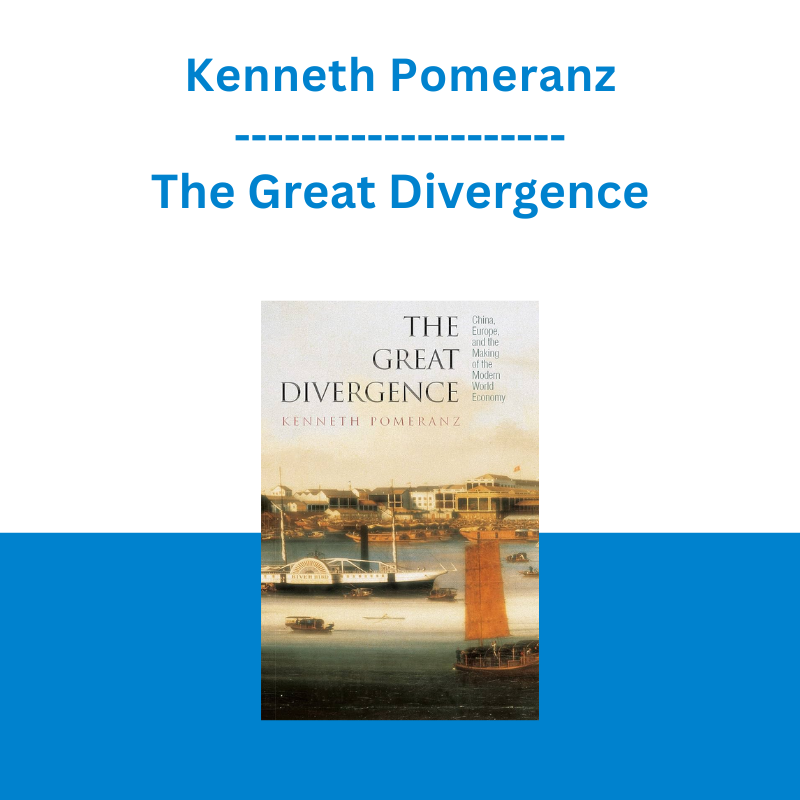*** Proof of Product ***
Exploring the Essential Features of “Kenneth Pomeranz – The Great Divergence: China, Europe, and the Making of the Modern World Economy”
Please see the full list of alternative group-buy courses available here: https://lunacourse.com/shop/The Great Divergence: China, Europe, and the Making of the Modern World Economy. Paperback
by Kenneth Pomeranz (Author)
The Great Divergence brings new insight to one of the classic questions of history: Why did sustained industrial growth begin in Northwest Europe, despite surprising similarities between advanced areas of Europe and East Asia? As Ken Pomeranz shows, as recently as 1750, parallels between these two parts of the world were very high in life expectancy, consumption, product and factor markets, and the strategies of households. Perhaps most surprisingly, Pomeranz demonstrates that the Chinese and Japanese cores were no worse off ecologically than Western Europe. Core areas throughout the eighteenth-century Old World faced comparable local shortages of land-intensive products, shortages that were only partly resolved by trade.
Pomeranz argues that Europe’s nineteenth-century divergence from the Old World owes much to the fortunate location of coal, which substituted for timber. This made Europe’s failure to use its land intensively much less of a problem, while allowing growth in energy-intensive industries. Another crucial difference that he notes has to do with trade. Fortuitous global conjunctures made the Americas a greater source of needed primary products for Europe than any Asian periphery. This allowed Northwest Europe to grow dramatically in population, specialize further in manufactures, and remove labor from the land, using increased imports rather than maximizing yields. Together, coal and the New World allowed Europe to grow along resource-intensive, labor-saving paths.
Meanwhile, Asia hit a cul-de-sac. Although the East Asian hinterlands boomed after 1750, both in population and in manufacturing, this growth prevented these peripheral regions from exporting vital resources to the cloth-producing Yangzi Delta. As a result, growth in the core of East Asia’s economy essentially stopped, and what growth did exist was forced along labor-intensive, resource-saving paths–paths Europe could have been forced down, too, had it not been for favorable resource stocks from underground and overseas.
Review
“Winner of the 2000 John K. Fairbank Prize, American Historical Association”
“Co-Winner of the 2001 Book Prize, World History Association”
“One of Choice’s Outstanding Academic Titles for 2000”
“The vast international disparity in incomes and standards of living between Western Europe and its offshoots on the one hand, and most of Asia, Africa, and Latin America on the other, is a striking feature of the modern world. Pomeranz’s study is an important addition to the literature that challenges elements of every major interpretation of the European take-off.” ― Choice
“A profoundly though-provoking book which will change the terms of the debate about the origins of capitalism, the rise of the West and the fall of the East.”—Jack Goody, Times Higher Education Supplement
“This book makes, bar none, the biggest and most important contribution to our new understanding of the causes and mechanisms that brought about the great divergence’ between the West and the rest of China in particular. . . . An entirely new and refreshing departure. Although he makes new comparisons between Europe, China, Japan, India, Southeast Asia, Pomeranz also connects all these and more in a bold new sweep that should immediately make all previous and most contemporary related work obsolescent.”—Andre Gunde Frank, Journal of Asian Studies
“This book is very important and will have to be taken seriously by anyone who thinks that explaining the Industrial Revolution . . . is crucial to our understanding of the modern world. . . . [A] book so rich that fresh insights emerge from virtually every page.”—Robert B. Marks, American Historical Review
“Exhaustively researched and brilliantly argued. . . . Suffice it to say that The Great Divergence is undoubtedly one of the most sophisticated and significant pieces of cliometric scholarship to be published of late, especially in the field of world history.””—Edward R. Slack, Jr., Journal of World History
Review
“Pomeranz uses that European invention―economics―to overturn Eurocentrism, establishing beyond cavil a New Fact in our world. Never again will Europeans imagine they stood alone in the doorway of economic growth. Pomeranz and his colleagues in the new sinology have reintroduced the Central Kingdom and its stunning historical sources, and Pomeranz has written the one essential book.”―Deirdre McClosky, University of Iowa
“Pomeranz uses a mixture of institutional forces and technological/geological luck to explain how an economic and ecological ‘tie game’ suddenly became a victory for western Europe over China. He combines global imagination with the scientific detail needed to make his points hold firm. The Great Divergence should command widespread respect.”―Peter H. Lindert, University of California, Davis
“A truly magisterial effort based on an immense knowledge of the field, a vast amount of reading, and on close and careful analysis, informed by both social science and history.”―Joel Mokyr, Northwestern University
“This is an outstanding book, painstaking and devastating in its attack on received wisdom, supported by a wealth of solid evidence and elegant argument.”―Jack A. Goldstone, University of California, Davis
From the Back Cover
“Pomeranz uses that European invention–economics–to overturn Eurocentrism, establishing beyond cavil a New Fact in our world. Never again will Europeans imagine they stood alone in the doorway of economic growth. Pomeranz and his colleagues in the new sinology have reintroduced the Central Kingdom and its stunning historical sources, and Pomeranz has written the one essential book.”--Deirdre McClosky, University of Iowa
“Pomeranz uses a mixture of institutional forces and technological/geological luck to explain how an economic and ecological ‘tie game’ suddenly became a victory for western Europe over China. He combines global imagination with the scientific detail needed to make his points hold firm. The Great Divergence should command widespread respect.”–Peter H. Lindert, University of California, Davis
“A truly magisterial effort based on an immense knowledge of the field, a vast amount of reading, and on close and careful analysis, informed by both social science and history.”–Joel Mokyr, Northwestern University
“This is an outstanding book, painstaking and devastating in its attack on received wisdom, supported by a wealth of solid evidence and elegant argument.”–Jack A. Goldstone, University of California, Davis
About the Author
Kenneth Pomeranz is Professor of History at the University of California, Irvine. He is author of The Making of a Hinterland: State, Society, and Economy in Inland North China, 1853-1937, which won the John King Fairbank Prize from the American Historical Association, and coauthor (with Steven Topik) of The World that Trade Created.
Product details
Publisher : Princeton University Press; Revised edition
Language : English
Paperback : 392 pages
Customer reviews
E. N. Anderson
Why Europe Won?
In this excellent, tightly reasoned, and data-filled book, Kenneth Pomerantz argues that Europe grew rich, industrial, and mighty after 1500 largely because of expansion, colonization and exploitation of much of the world (and also by making use of strategically convenient resources at home). Conversely, China, economically and scientifically more developed than Europe as of 1000 or 1100, fell behind after 1500. Only Europe developed what Randall Collins calls “rapid development science” in his work THE SOCIOLOGY OF PHILOSOPHIES; the Chinese, Indians, and even Native American civilizations had excellent science, but based on very different plans, and they never made the breakthrough to the rapid development institutions. Pomerantz may paint a bit too rosy a picture of China at times, but the point is true enough. This book should absolutely end the facile racist and “culturist” explanations of S. Huntington, D. Landes and their ilk. Europe was not somehow superior all along; it took rapid advantage of a special situation. There may be more to the story–many (including Landes–who is right in this case) have pointed out that Europe’s division into many rival states helped, because several of them found it to their strategic advantage to be ahead of the others in gaining information and developing technology. There will be ongoing debate about what are the drivers of Europe’s sudden burst, but, after this book, no one can afford to ignore China’s successes and the difficulties they make for conventional models.
Listo
Puts the Industrial Revolution into perspective
I was taught in high school that the Industrial Revolution came about in England through technological innovation, which led to a fundamental reordering of British society, with old cottage industries overtaken by factories and with country laborers drawn into new, large, cities with perennial grey skies. Later on in lower division history survey course, I was taught that the depletion of English forests to supply the Royal Navy meant that those forests had to be protected and forced Englishmen to look elsewhere for fuel, namely underground, and that the struggle to keep the coal mines from flooding and to transport the coal long distances led to the development of the steam engine, which could then be put to a variety of labor-saving industrial tasks. This book doesn’t address these issues so much. What it does do is provide international context to the Industrial Revolution, comparing the economies, laws, natural resources and social structures of Britain and China and Japan, and occasionally India or a few European nations to try and answer the question: Why England, or more broadly, which is what Pommeranz asks: Why Europe? To put, for example, China and Britain into context, he includes Britain as part of Europe, because it makes more sense to compare to large landmasses with large populations, some broadly shared cultural traits to each other. After all, he points out, while China’s external trade paled in comparison with European trade in the 19th century, the nation’s INTERNAL trade was just as robust as Europe’s. Certain persistent myths about the Western cultural foundations of Capitalism should be thrown out– in 1750 it was easier to buy and sell land on the private market in China than in England, which in retained more feudalistic social and economic structures later than did China. What Pommeranz suggests is that the great economic (and indeed political) lead that Britain and other western powers took on the world stage only occurred in the very late 19th century and lasted relatively shortly. Furthermore, he argues that it was not inevitable that only Britain (or other Europeans) would have developed the Industrial technologies that allowed for so much of European imperial successes, but that other countries (specifically China and Japan) very well could have produced similar technologies given the time or correct . Basically, it was not a matter of cultural determinism à la Weber that the Industrial Revolution occured, but rather largely through more proximate factors. The subject itself is interesting, but the evidence at times can be yawn-inducing. Charts and tables on productivity and the like aren’t exactly page-turners for me. This is a must-read for anyone interested in the formation of Industrial economies and in the shaping of the modern world, assuming you have the patience to wade through the economic data. Pommeranz offers a compelling, if non-traditional, view of the Industrial Revolution. In history, context is everything, and this book helps provide that.










 Ed Ponsi - Forex Trading
Ed Ponsi - Forex Trading  George Fontanills & Tom Gentile - Optionetics 6 DVD Series Home Study Course (Digital Download)
George Fontanills & Tom Gentile - Optionetics 6 DVD Series Home Study Course (Digital Download)  Emanuele Bonanni - My Trading Way
Emanuele Bonanni - My Trading Way  Chris Capre - Advanced Price Action Ongoing Training & Webinars
Chris Capre - Advanced Price Action Ongoing Training & Webinars  George Fontanills & Tom Gentile - Optionetics Wealth Without Worry Course
George Fontanills & Tom Gentile - Optionetics Wealth Without Worry Course  Erik Banks - Alternative Risk Transfer
Erik Banks - Alternative Risk Transfer  Fred Haug - Virtual Wholesaling Simplified
Fred Haug - Virtual Wholesaling Simplified  Team NFT Money - Ultimate NFT Playbook
Team NFT Money - Ultimate NFT Playbook  Dave Landry - Stock Selection Course
Dave Landry - Stock Selection Course  Greg Loehr - Advanced Option Trading With Broken Wing Butterflies
Greg Loehr - Advanced Option Trading With Broken Wing Butterflies  Trade Like Mike - The TLM Playbook 2022
Trade Like Mike - The TLM Playbook 2022  Simpler Trading - Bruce Marshall - The Options Defense Course
Simpler Trading - Bruce Marshall - The Options Defense Course  Atlas API Training - API 570 Exam Prep Training Course
Atlas API Training - API 570 Exam Prep Training Course  Racing Workshop - Complete Online Package
Racing Workshop - Complete Online Package  Jesse Livermore Trading System - Joe Marwood
Jesse Livermore Trading System - Joe Marwood  Advanced Treatment Considerations for Women with ADHD - Michelle Frank
Advanced Treatment Considerations for Women with ADHD - Michelle Frank  The Foot Collective - Workshop 1.0
The Foot Collective - Workshop 1.0  Sovereign Man Confidential - Renunciation Video
Sovereign Man Confidential - Renunciation Video  Matthew Kratter - Trader University
Matthew Kratter - Trader University  The Daily Traders – Exclusive Trading Mentorship Group
The Daily Traders – Exclusive Trading Mentorship Group